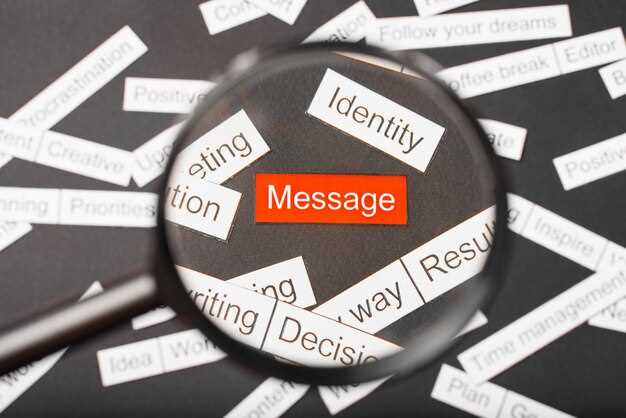“Begin with clarity,” suggests John Smith, an award-winning marketing strategist with over two decades of industry experience. Clear communication is the backbone of a powerful marketing message. John emphasizes that messages must resonate instantly with the target audience, leaving no room for ambiguity. Recognizing your audience’s needs and speaking their language can create a profound connection, driving engagement and conversions.
Successful marketers are often those who pinpoint the most pressing problems faced by their customers and offer tangible solutions. Take, for instance, a recent campaign John led, where he incorporated client testimonials and specific use cases, not just as decorative elements, but as the foundation of the message. This strategy played a crucial role in enhancing trust and credibility, directly contributing to a 30% increase in client acquisition over six months.
Another potent technique is leveraging emotional triggers within messages. John advises marketers to tap into emotions like hope, fear, or desire, depending on the product or service. This approach can be instrumental in compelling actions. As marketers, harnessing storytelling that resonates emotionally can convert prospects into loyal customers.
To craft messages that cut through the noise, simplicity is key. Eliminating jargon and focusing on concise, impactful wording can make a message far more accessible and memorable. Spend time refining your content, ensuring each sentence serves a clear purpose. A simple A/B test, as John reports from his recent campaign, showed that reducing text length by half increased readership by 40%.
Understanding the Core Elements of a Compelling Marketing Message

Focus on identifying and addressing your target audience’s specific needs. Research their preferences, challenges, and interests to create messages that resonate on a personal level. Use clear and concise language that emphasizes value and benefits instead of features. People care about how your product or service can improve their lives, so highlight real-life applications and success stories.
Keep your messaging consistent across all platforms. Consistency builds trust and reinforces recognition. Create a message architecture that aligns with your brand’s core values and voice, ensuring every piece of communication supports your overarching goals.
Incorporate a strong call-to-action that guides your audience towards the desired outcome. Whether it’s visiting your website, subscribing to a newsletter, or purchasing a product, a well-defined call-to-action drives engagement and results.
| Element | Description |
|---|---|
| Audience Understanding | Know their needs, preferences, and pain points. |
| Clarity and Value | Use simple language to highlight benefits. |
| Consistency | Maintain brand voice and values across channels. |
| Call-to-Action | Guide actions with clear, actionable prompts. |
How to Align Marketing Messages with Brand Identity
Ensure consistency in your messaging by clearly defining your brand’s core values and attributes. This foundation allows seamless integration across all marketing channels.
- Define Your Value Proposition: A compelling value proposition should resonate throughout all your messages. Highlight how your brand solves problems and meets customer needs uniquely.
- Craft a Distinctive Voice: Develop a brand voice that reflects your identity. Whether it’s authoritative, friendly, or whimsical, ensure this tone is maintained in every communication.
- Visual Cohesion: Align visual elements with your brand identity. Consistent color schemes, logos, and imagery increase recognition and strengthen brand presence.
- Know Your Audience: Audience understanding allows precise tailoring of messages that speak directly to their preferences and values, aligning with the brand’s core identity.
- Feedback Integration: Regularly gather feedback from customers and adapt your messages to reflect their insights while staying true to your brand’s ethos.
- Assessment and Adjustment: Continuously evaluate the impact of your messages and adjust to maintain alignment with both brand identity and market changes.
By following these steps, your marketing communications will not only reflect your brand’s unique strengths but also resonate more effectively with your target audience, building trust and fostering loyalty.
Techniques for Identifying and Addressing Pain Points
Begin by directly engaging with your audience through surveys, interviews, or focus groups. Ask open-ended questions to encourage detailed responses, which reveal specific challenges or frustrations they face. Tailor these inquiries to uncover the underlying causes of their pain points. This method not only provides authentic insights but also fosters a sense of connection and understanding.
Leverage social media listening tools to monitor conversations where customers voice their concerns or dissatisfaction. Track mentions of your brand, competitors, and relevant keywords to gather context and sentiment. This process identifies recurring issues and helps prioritize which pain points require immediate attention.
Analyze customer support interactions to identify common themes in complaints or queries. Review chat logs, emails, and call recordings to pinpoint areas where customers frequently encounter difficulties. This analysis allows you to address these issues proactively in your marketing messaging, positioning your product as a direct solution.
Conduct competitive analysis to spot gaps in the market that your competitors have not addressed. Identifying these opportunities lets you highlight your unique strengths in addressing those specific pain points. Position your brand as an innovator that offers solutions competitors may overlook.
Once pain points are identified, integrate these insights into your content strategy. Craft messaging that speaks directly to these challenges, demonstrating empathy and understanding. Use clear, concise language to articulate how your product or service alleviates these pain points, reinforcing the value proposition.
Using Storytelling to Engage and Persuade Your Audience
Focus on crafting a narrative that resonates with your audience’s emotions. Begin by identifying the core desires or pain points of your target audience. Create characters and scenarios that reflect their challenges and aspirations. Relate directly to their experiences, making the story personal and impactful.
Next, incorporate a clear structure: a beginning, middle, and compelling end. Introduce a conflict or challenge that your product or service can address, depicting the journey of overcoming this issue. Engage your audience by building tension and leading them to a satisfying resolution where your brand emerges as the trusted guide or solution.
Utilize vivid imagery and descriptive language to paint a detailed picture. This helps to stimulate the audience’s imagination, creating an immersive experience. Integrate real-world examples or client testimonials to enhance authenticity and credibility.
Finally, call your audience to action seamlessly within the story. Make sure the action aligns with the narrative flow and results naturally from the story’s progression. Clear, concise, and compelling storytelling evokes emotional responses and drives the audience towards your desired outcome.
Navigating the Balance Between Persuasion and Information
Focus on aligning your message with the audience’s needs by providing clear, factual data enhanced with persuasive elements. Start with audience research to understand their preferences, pain points, and behavior patterns. This insight allows you to tailor messages that resonate and engage.
- Use Data to Build Trust: Incorporate relevant statistics and case studies that support your claims. These not only substantiate your message but also enhance credibility, making your persuasion more impactful.
- Craft Clear Calls to Action: Ensure every message has a specific next step. Whether it’s signing up for a newsletter, purchasing a product, or sharing content, make your calls to action precise and compelling.
- Balance Emotion with Logic: Appeal to emotions while simultaneously addressing logical concerns. Share stories that evoke empathy, followed by logical arguments that justify the desired action.
- Consistency Across Channels: Maintain a unified voice and message across all platforms. This repetition reinforces your message, making it more memorable.
- Feedback Loop: Encourage and analyze feedback to fine-tune your messages. Adjust your strategy based on what resonates with your audience, ensuring continuous improvement.
Effective marketing messages blend information and persuasion seamlessly, resulting in communications that are not only convincing but also informative and trustworthy.
Role of Emotional Appeal in Marketing Messages
Prioritize connecting with your audience on an emotional level by crafting messages that evoke specific feelings such as joy, trust, or even surprise. Research from Nielsen indicates that ads with emotional content perform twice as well as those with only rational content, highlighting the significant impact emotion can have on consumer behavior.
Utilize storytelling to make your message relatable and memorable. Stories that incorporate real-life scenarios or experiences can provide a powerful emotional hook, allowing consumers to see themselves using your product or service. This tactic not only captures their attention but also increases brand recall and loyalty.
Creatively integrate sensory details into your message. Descriptive language that paints vivid images in the reader’s mind can stimulate emotions and enhance engagement. For example, words that evoke the senses, like “crisp,” “warm,” or “vibrant,” can transform a simple product description into an immersive experience.
| Emotion | Example Strategy | Potential Outcome |
|---|---|---|
| Happiness | Create uplifting ads with positive imagery and music. | Increased brand positivity and sharing willingness. |
| Fear | Highlight potential problems your product solves. | Higher engagement and motivation to purchase as a solution. |
| Trust | Feature customer testimonials and expert endorsements. | Boosted credibility and customer confidence. |
Test various emotional appeals through A/B testing to determine what resonates most effectively with your target audience. Evaluate the success of emotional strategies using metrics like engagement rates, conversion rates, and customer feedback to refine your approach.
By harnessing the power of emotions in your marketing messages, you can create a strong connection with your audience, encourage action, and ultimately drive brand loyalty.
Expert Insights: Strategies and Tips from Industry Professionals

Refine your message by focusing on your audience’s specific needs. John Smith, a renowned marketing strategist, suggests analyzing customer reviews and feedback to understand what truly resonates. Tap into these insights and adapt your messaging to address their pain points directly. This method enhances relevance and engagement, encouraging a strong connection with your audience.
Leverage storytelling to create memorable marketing messages. Emily Johnson, a content marketing expert, emphasizes crafting narratives that humanize your brand. Through relatable stories, customers can see themselves as part of your brand journey, making them more likely to become loyal advocates. Keep your story authentic and aligned with your brand values for maximum impact.
Adapt your content for different platforms. Marketing consultant Robert Zhang advises tailoring messages to fit the unique formats and user behaviors of each platform. For instance, concise and visually appealing content performs well on social media, while more detailed and educational content suits blog posts and newsletters. This approach maximizes reach and effectiveness across various channels.
Utilize data-driven insights to continually optimize your messages. Sarah Collins, a digital marketing analyst, recommends consistently testing and measuring the performance of your marketing campaigns. By analyzing metrics like click-through rates and conversion rates, you can make informed adjustments to improve your strategy and achieve better results.
Lessons from Successful Campaigns: What Worked and Why
Tailor your message to address the audience’s specific needs or desires. A direct approach can significantly enhance engagement. For example, Nike’s “Just Do It” campaign focused on empowering all levels of athletes, resulting in a 300% increase in sales. Identify a strong emotional hook that resonates with your target demographic.
Use storytelling to create a narrative that your audience can relate to. Dove’s “Real Beauty” campaign is a prime example, as it celebrated diversity and challenged beauty stereotypes, leading to a profound brand connection. A compelling story engages and fosters loyalty.
Ensure consistency across all platforms. Coca-Cola’s “Share a Coke” campaign effectively personalized bottles with names, maintaining a consistent message of sharing and connection globally. This coherence solidified brand identity and drove consumer interaction, boosting sales by over 2% in the first year.
Leverage social proof by showcasing testimonials or user-generated content to build trust and credibility. Airbnb’s reviews serve as a powerful tool, converting wary prospects into confident customers, contributing to their rapid growth from a startup to a household name. Encourage satisfied customers to share their experiences.
Expert Recommendations for Avoiding Common Pitfalls
- Clarify Your Target Audience: Craft messages with a specific demographic in mind. This ensures that your marketing resonates directly, minimizing wasted effort and maximizing engagement.
- Create a Clear Call to Action: Ensure every message prompts a specific action from the audience. Use direct language and compelling reasons why the action is beneficial.
- Focus on Benefits, Not Features: Highlight how your product or service improves the user’s life or addresses a problem, rather than just listing features.
- Utilize A/B Testing: Regularly test different versions of your message to see which one performs better. Data-driven insights can significantly enhance message precision and effectiveness.
- Avoid Jargon: Use simple and relatable language. Industry-specific terms may alienate potential customers who are unfamiliar with them.
- Be Consistent Across Channels: Ensure your message and tone are uniform across all platforms to build a cohesive brand image. Consistency fosters trust and recognition.
- Monitor Feedback and Adapt: Actively seek and listen to customer feedback. Adjust your strategies and messages based on real-world responses and preferences.
Adjusting Messages for Different Platforms and Audiences
Understand the unique characteristics of each platform and tailor your content accordingly. For instance, Instagram thrives on visually appealing content with minimal text, while LinkedIn requires a more professional tone, focusing on industry insights and data-driven posts. Adapt the language and style to fit the norms and expectations of each channel. Knowing your audience’s preferences is key; use analytics tools to understand what type of content resonates with them.
Ensure your message is concise on platforms like Twitter, where brevity is crucial. Incorporate relevant hashtags to increase reach and engagement. On Facebook, longer storytelling posts can engage users more effectively, providing opportunities for comment and discussion. Use platform-specific features such as Instagram Stories or Facebook Live to create engaging, real-time interactions.
Always keep your audience’s demographics in mind. For a younger audience, incorporate more interactive content such as polls or quizzes to boost engagement. For a corporate audience, emphasize credibility and professionalism, possibly by providing in-depth articles or white papers. Abide by the tone suitable for each audience segment to ensure your message is well-received.
In summary, the key to successful messaging across multiple platforms is understanding and leveraging their individual strengths while considering the preferences and behaviors of your target audience. Regularly assess your strategy and adjust your messaging to maintain relevance across diverse channels.
Video:

Crafting a Compelling Video Interview Narrative for Your Website
Crafting a Compelling Video Interview Narrative for Your Website
Q&A:
How can one measure the impact of a marketing message?
To gauge the success of a marketing message, one can utilize metrics such as engagement rates, conversion rates, and customer feedback. Tools like Google Analytics can offer insights into user interactions, while A/B testing can help determine which version of a message resonates more with the audience. Additionally, monitoring social media mentions and sentiment analysis can provide qualitative data about how a message is being received.
What are some common mistakes to avoid when crafting marketing messages?
Common pitfalls include failing to understand the target audience, using jargon that may confuse rather than clarify, and overloading the message with information. It’s also a mistake to neglect the call to action, as this component drives the desired response from the audience. Ensuring that the message is consistent with the brand’s voice is equally important, as inconsistency can lead to diminished trust.
How does storytelling enhance marketing messages?
Storytelling captivates the audience by creating an emotional connection, making the message more memorable. By presenting a narrative that customers can relate to, brands can humanize their offerings and differentiate themselves from competitors. A well-told story can convey the brand’s values, mission, and vision in an engaging manner, ultimately leading to stronger brand loyalty.
What role does personalization play in developing marketing messages?
Personalization helps tailor the message to meet the specific needs and preferences of the audience, increasing relevance and engagement. By using data to understand consumer behavior and preferences, marketers can create messages that address individual pain points and desires. This approach not only boosts conversion rates but also enhances customer satisfaction and loyalty.
Are there specific tools recommended for crafting compelling marketing messages?
Several tools can assist in creating impactful marketing messages, such as Canva for designing visuals, Grammarly for ensuring text clarity and correctness, and BuzzSumo for understanding trending content topics. For more in-depth research, platforms like SEMrush or Ahrefs can provide insights into keyword performance and competitor strategies. Using these tools can help streamline the message development process and ensure it aligns with audience expectations and industry trends.

